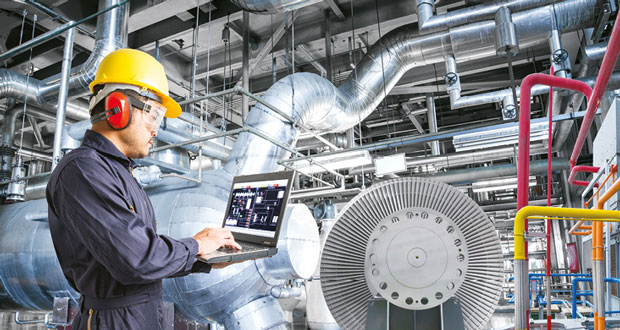New research reveals that despite overwhelming recognition of the value of predictive and connected maintenance, most companies are struggling to digitalise their operations.
Europe’s maintenance sector is showing growing appetite for digital transformation, as two-thirds (63 per cent) of firms are embarking on their digitalisation journey. This is according to a new study by the Germany-based software developer osapiens in collaboration with the Fraunhofer Institute for Material Flow and Logistics IML (Fraunhofer IML). It found that nearly all companies (92 per cent) across the continent are confident in the impact of digital maintenance tools, but are struggling to make progress in their digitalisation to drive a return on investment.
“Many companies believe they are already digitally advanced, but what we typically see are isolated systems rather than fully integrated ones,” said Dr.-Ing. Thomas Heller, Managing Director of the Fraunhofer Smart Maintenance Community and Head of Department Facilities and Service Management at Fraunhofer IML. “The next step is connecting these systems – creating visibility across data, processes, and people. That’s where the true value of digital maintenance begins.”
The study ‘Industrial Maintenance in Transition‘ surveyed 407 maintenance leaders in mid-sized manufacturing companies across the UK and continental Europe, exploring the state of maintenance transformation and barriers to progress.
Almost all surveyed companies (92 per cent) recognise the value of predictive and connected operations for their maintenance. Yet, digitalisation remains uneven.
When it comes to planning, about a third (31 per cent) of organisations rely on ERP systems, while a similar proportion (29 per cent) still use spreadsheets. For execution, 59 per cent of companies still depend on Excel or Google Sheets, 49 per cent use ERP systems, and 41 per cent still work with paper-based checklists. Adoption of CMMS tools (Computerised Maintenance Management System) for execution remains limited with just six per cent using one.
CMMS platforms are a highly anticipated maintenance technology which is said to restructure reactive firefighting into intelligent Predictive Maintenance. Less than a third (28 per cent) of respondents describe their processes as fully planned and preventive, while another 37 per cent describe them as fully planned and reactive. The majority combine elements of both and often struggle to maintain consistency.
Technology poses a problem, and organisations are slow to switch to fully integrated CMMS due to integration, with existing systems being the main hurdle (43 per cent) followed by cultural resistance (38 per cent). Around a third suffer from limited IT resources and a shortage of digital skills.
Maintenance Maturity Index
For the survey, Fraunhofer IML and osapiens developed a Maintenance Maturity Index. This five-stage model shows how organisations progress from manual, reactive practices to intelligent, predictive maintenance. It allows firms to benchmark themselves against their peers and provides a practical roadmap.
The index analysis revealed three key findings: 35 per cent of European companies have reached Stage 2, having digitised the basics. Another 25 per cent have advanced to Stage 3 and are using structured systems, such as CMMS or ERP modules. Only 15 per cent have achieved higher maintenance maturity: 10 per cent have integrated maintenance into production planning (Stage 4), and five per cent operate fully predictive systems. A quarter of organisations remain at the lowest, reactive stage.
Technological progress in maintenance maturity goes hand in hand with the adoption of AI, in terms of both potential and wariness of adoption. Most organisations currently use AI tactically: 43 per cent for workflow automation, 40 per cent for knowledge management via chatbots, and 34 per cent for anomaly detection. Mid-sized firms prioritise quick efficiency gains over fully predictive or integrated strategies.
While 92 per cent of firms are convinced that digital tools can deliver measurable ROI, few can demonstrate it with hard data. Adoption of KPI dashboards – one of the clearest indicators of return – stands at just 40 per cent. Other ROI-proving tools, such as integration with ERP and production systems (34.5 per cent) or digital SOPs (34.3 per cent), remain below the halfway mark.
Daniel Schwarz, Co-Founder of osapiens Asset Ops commented: “Companies know that digital maintenance delivers value. What they need to do now is to make that value visible. Those that succeed will turn maintenance into a true source of competitive advantage.”
The full Maintenance in Transition Report can be downloaded here.
Workspace management: One-size-fits-all booking systems don’t work anymore
The way we work has changed – yet, many organisations are still relying on rigid, one-size-fits-all tools to manage desks and meeting rooms, according to a new study from workplace management solutions provider, Matrix Booking.
Spreadsheets, calendars, and generic booking software may have worked once, but they’re struggling to keep pace with today’s flexible, hybrid workforce. The result? Wasted time, frustrated employees, and expensive underutilised space.
Matrix Booking’s new study, ‘One-size-fits-all booking systems don’t work for today’s workforce’, explores why current systems are falling short – and how organisations can reimagine workspace management to boost efficiency, employee experience, and cost savings.
To download your FREE copy click here.





